Image Relay vs. OpenAsset
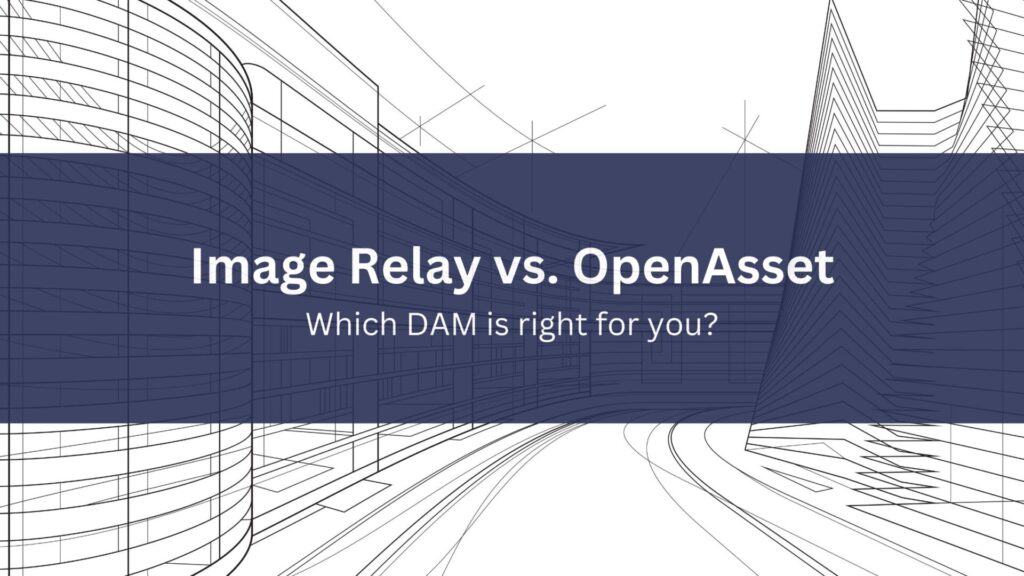
Selecting the right Digital Asset Management (DAM) system is essential for businesses looking to optimize their digital asset organization and enhance team collaboration.
When comparing DAM systems, you should consider factors such as team size, industry requirements, budget constraints, necessary features like search capabilities and integration options, and the intended use of the assets in marketing or sales efforts.
DAM platforms cater to digital asset management needs, but each platform approaches tasks differently and offers distinct benefits suited to different types of organizations. Therefore, each has its own set of features and capabilities that make it suitable for certain preferences and requirements within the DAM landscape.
But, which one is right for you and your organization’s needs?
In this blog, we will compare two top DAM systems: OpenAsset and Image Relay. This blog aims to help you understand which DAM solution, OpenAsset or Image Relay, best aligns with your organization’s needs, helping you make a more informed decision.
What Is DAM?
Digital Asset Management (DAM) software is a centralized repository that helps organizations efficiently store, organize, manage, access, and distribute their digital content.
DAM systems are designed to handle a variety of media files including images, videos, audio files, presentations, and documents. The primary goal of DAM software is to enhance the accessibility and control over a company’s digital assets, making it easier for teams to find and use content across different departments and projects.
DAM systems often come with features like metadata management, which allows users to tag and categorize assets for easier searchability; version control, ensuring the most current files are readily available; and rights management, which helps in tracking the usage rights and licensing information of assets.
This kind of software is invaluable for organizations that deal with large volumes of digital media, helping to streamline workflows, improve collaboration, and secure digital assets.
| Hand-picked related content: Learn about the top DAM features you should look for when shopping for the perfect DAM solution by reading our blog on the 7 Most Important DAM Features now. |
What Is OpenAsset?
OpenAsset is a Digital Asset Management (DAM) software specifically tailored for architecture, engineering, and construction. OpenAsset streamlines the proposal and project presentation processes within these industries.
It provides a platform for these businesses to efficiently manage and utilize their extensive collections of project images and marketing collateral. OpenAsset is designed to integrate seamlessly with project-based workflows, helping firms to organize, store, and share digital assets throughout the lifecycle of their projects.
| Hand-picked related content: Want to learn more about how OpenAsset can transform your AEC firm? Read our blog on Top OpenAsset Features Every User Should Know. |
What Is Image Relay?
Image Relay markets itself as a unified platform combining Digital Asset Management (DAM) and Product Information Management (PIM), which simplifies the tech ecosystem for companies, particularly those dealing with products.
It offers robust features for organizing, managing, and sharing digital assets and product information, aiming to streamline workflows, ensure brand consistency, and accelerate marketing delivery.
Image Relay vs. OpenAsset: Top Industries
Choosing the right Digital Asset Management (DAM) system largely depends on the specific needs, workflows, and compliance standards of your industry. Different sectors have distinct requirements that dictate an optimal DAM solution’s essential features and functionalities.
Here’s how Image Relay and OpenAsset compare when it comes to the top industries they serve:
Image Relay
Image Relay’s DAM system caters to a wide range of industries, mostly in the mid-market. While it is not as specialized as OpenAsset in the AEC sector, it offers robust functionality for other top industries. Here are some industries that Image Relay supports:
- Marketing and Advertising
- Education
- Non-Profit Organizations
- Healthcare
- Retail
These industries benefit from Image Relay’s generalist approach, which offers a broad set of features such as secure file sharing, robust metadata tagging, and integrations with other business tools, providing a reliable and scalable solution for managing a diverse range of digital assets.

OpenAsset
On the other hand, OpenAsset particularly specializes in the following sectors:
Firms across various sizes—predominantly in the mid-market range—choose OpenAsset due to its proficiency in streamlining asset management and enhancing workflow efficiency within the AEC industry.
Its features cater to the unique needs of AEC firms, including project-specific asset organization, integration with AEC-dedicated software, and capabilities to effectively manage and display project portfolios and resumes.
Additionally, while OpenAsset is primarily tailored for the AEC industry, it also serves well for other professional service firms involved in extensive project-based asset management, such as real estate and design firms.

Image Relay vs. OpenAsset: Capabilities
When comparing Image Relay and OpenAsset, it’s essential to focus on how each platform caters to the specific needs of your business and industry. While both are competent DAM systems, OpenAsset offers several robust functionalities that are particularly advantageous for AEC firms.
Let’s take a closer look at some of the standout features and how they compare:
Organization
Organization features in a DAM system are crucial because they streamline the management of digital assets, making them easily accessible and usable.
Effective organization reduces the time spent searching for assets, supports compliance with copyright and usage rights, and enhances collaboration by ensuring team members have timely access to the correct files.
Let’s take a look at how Image Relay’s and OpenAsset’s organization features compare:
Image Relay

Image Relay organization features help manage digital assets efficiently. The backbone of Image Relay’s organization strategy is a logical folder structure that categorizes assets, making them easy to locate and manage. Users can create folders based on various criteria like project type, client, or year, and modify them as needs change.
Moreover, Image Relay uses comprehensive metadata fields that are customizable to match the needs of different industries and projects. This includes standard fields like file size, format, and upload date, as well as IPTC data.
Image Relay also supports the creation of custom metadata templates, allowing for even more detailed categorization and organization of assets.
To further enhance asset discoverability, Image Relay includes an AI tagging feature that automatically assigns relevant tags to images. This feature simplifies the tagging process, making it faster and ensuring consistency across tags.
These features make assets both easy to find and well-organized within the Image Relay platform.
OpenAsset
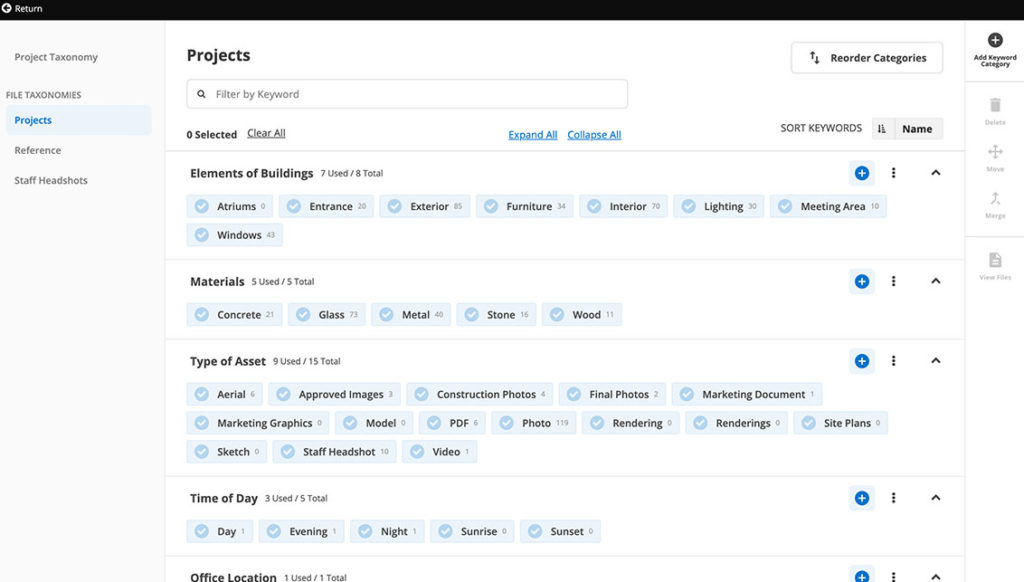
OpenAsset optimizes the organization of digital assets by focusing on a project-centric structure, which is particularly advantageous for AEC firms.
These firms typically generate a large volume of visual content and documents for each project, and OpenAsset’s system allows these assets to be linked directly to specific projects, making it easier for users to locate the materials they need efficiently.
To ensure ongoing organization and easy retrieval, OpenAsset employs a consistent keyword taxonomy along with a project-focused organizational structure. This method ensures that assets are easily discoverable and remain searchable throughout their lifecycle, facilitating smooth access and management.
Along with its search features, which we’ll get into below, these organization features in OpenAsset help AEC firms efficiently manage, retrieve, and utilize their growing library of project-related digital assets, enhancing productivity and streamlining project documentation workflows.
Search
Search features are a critical component of any DAM system because they significantly reduce the time and effort required to locate specific assets within a large and often complex digital library.
Efficient search capabilities ensure that users can quickly find the exact files they need, enhancing productivity and supporting more streamlined workflows. This is particularly crucial because previous studies show workers can spend a considerable portion of their time just searching for files.
Here’s how Image Relay and OpenAsset compare when it comes to their search features:
Image Relay
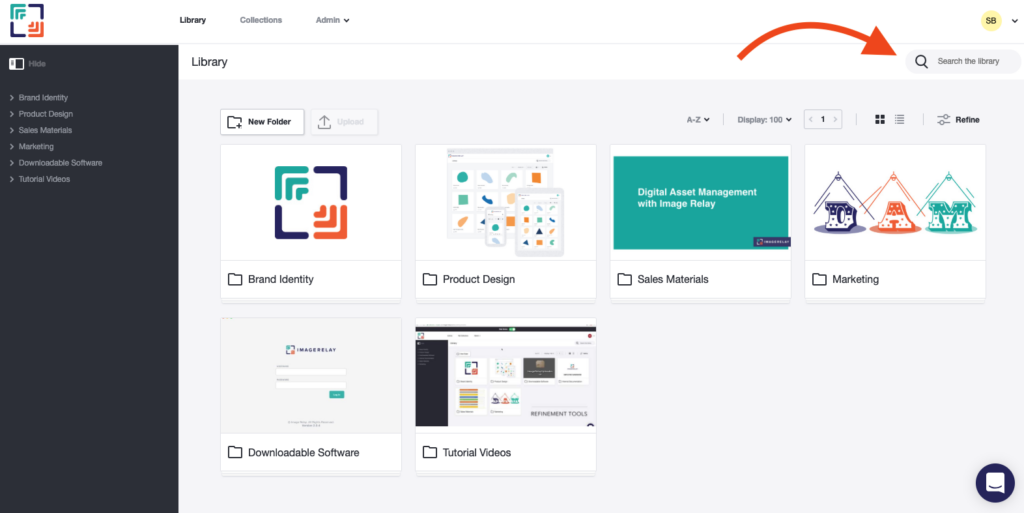
Image Relay offers a comprehensive suite of search tools designed to optimize the user experience by making it easier and faster to locate digital assets.
Image Relay allows users to search using a simple search box that indexes content across multiple attributes including metadata, folder names, file names, and tags. This ensures that relevant files are easily and quickly retrievable.
For more targeted searching, Image Relay’s advanced search feature lets users refine their searches by specific parameters like file names, metadata templates, document text, and more. This feature is especially useful for narrowing down results to the most relevant files based on detailed criteria.
Additionally, once a search has been conducted, Image Relay provides tools to further refine the search results. Users can filter files by file format, tags, orientation, color, and dates, among other criteria. This makes it possible to fine-tune search results to an even more specific subset of assets, ensuring users quickly find what they need.
OpenAsset
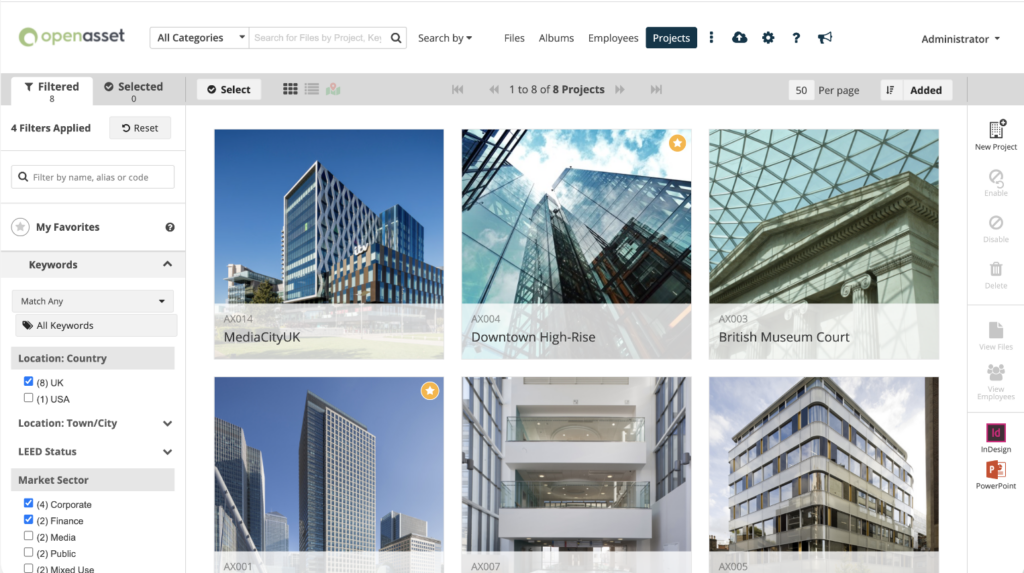
OpenAsset streamlines the search process for AEC firms, making it simple to locate the best digital assets for crafting compelling proposals. The software utilizes a standardized keyword taxonomy and a project-based organizational structure, ensuring that assets remain searchable and accessible throughout their lifecycle. This system supports long-term organization and easy retrieval of valuable assets.
In OpenAsset, you can perform searches using:
- Project keywords
- Project Metadata
- File keywords
- File metadata
Additionally, OpenAsset incorporates artificial intelligence (AI) in its search capabilities, enhancing the process by not only locating the correct files but also suggesting other relevant assets that might otherwise be overlooked. This AI-enhanced search functionality greatly improves the effectiveness of discovering assets.
The integration of sophisticated search tools and an extensive tagging system allows users to quickly pinpoint specific images or explore new ones within the system.
OpenAsset also enables users to create collections and albums based on specific search criteria. An important feature is the ability to use these images directly in applications like InDesign and PowerPoint without the need to download them first.
The comprehensive tagging system in OpenAsset ensures that the appropriate assets are easily found every time, making the search process both efficient and user-friendly, especially when handling large volumes of assets.
Templates
Templating features in a DAM tool allow for the creation and use of standardized document layouts and designs that ensure brand consistency across all materials. These features save time by streamlining the production of marketing materials, reports, and presentations, allowing team members to focus on content rather than design.
Here’s how Image Relay and OpenAsset compare when it comes to their templating features:
Image Relay

Image Relay offers a straightforward templating feature that enables the creation of marketing materials, making it ideal for collaboration with partners and retailers. You can choose from a variety of document sizes and create various types of content such as posters, leaflets, and website banners.
These templating features facilitate the design and distribution of marketing materials. Users can create, manage, and publish templates through a dedicated template management system.
This system allows for designing templates, locking design elements to prevent unwanted changes, and navigating through various configuration modes. Templates can be created from scratch or by modifying existing ones, and once completed, they can be published as new templates available for wider use within the organization.
However, these templating capabilities are more generalist and less focused on the specific needs of project-driven industries like AEC.
OpenAsset
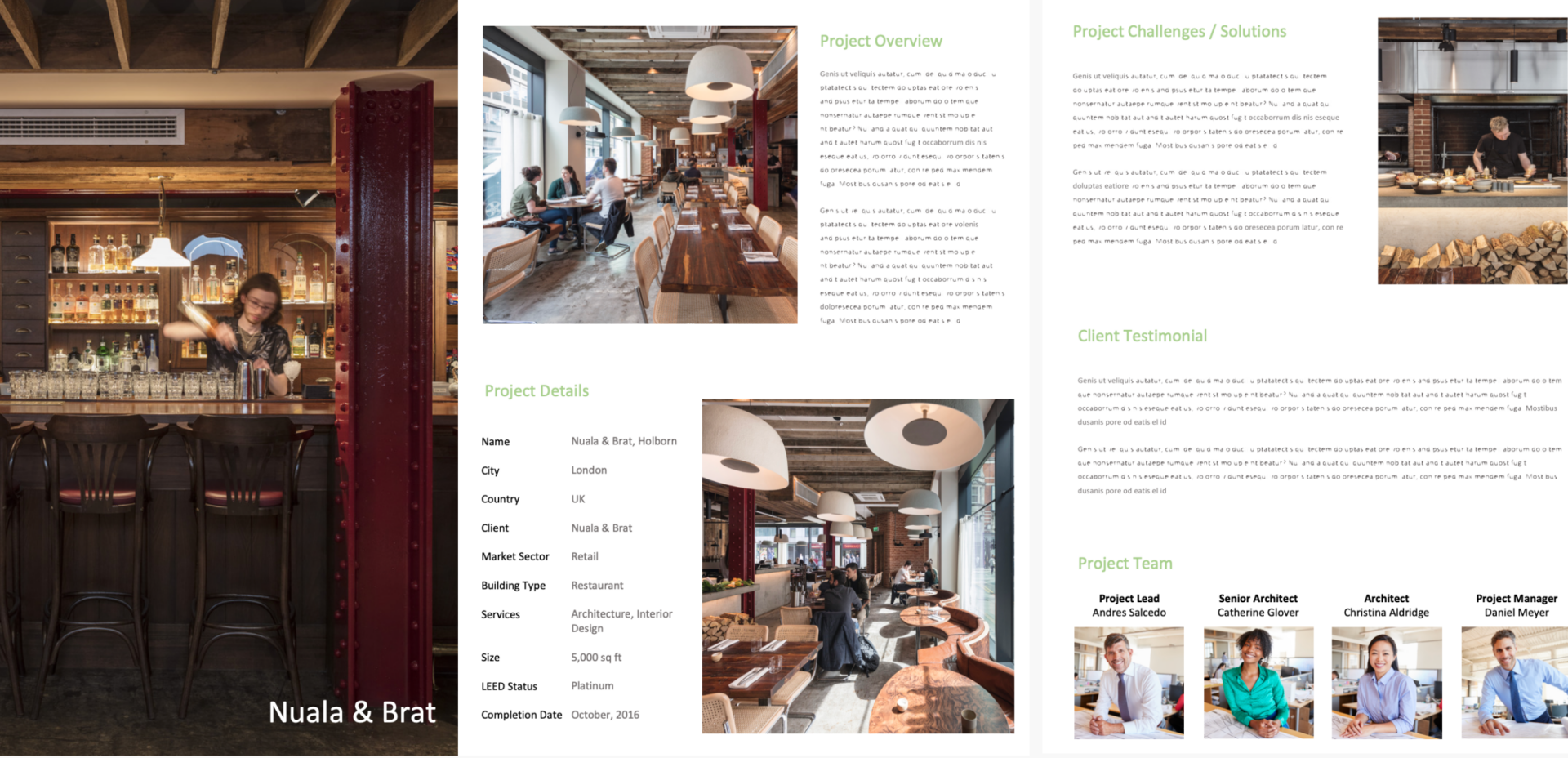
OpenAsset also offers powerful templating capabilities, particularly useful for creating customized documents quickly. The platform enables the creation of custom templates that can be used to generate documents directly within OpenAsset.
These templates are particularly valuable for AEC firms that need to produce consistent project documentation and proposals efficiently.
For example, the DAM platform offers a specialized Employee Module that integrates with InDesign, enabling the automatic generation of employee RFP resumes.
This feature allows firms to quickly produce custom and consistent resumes by pulling data directly from OpenAsset or an ERP system like Deltek Vision. This streamlines the creation process, significantly reducing the time spent on manual data entry and formatting.
Moreover, OpenAsset facilitates the creation of materials in PowerPoint and Word through its PowerPoint plug-in and Templafy Connector. These tools allow users to incorporate OpenAsset images directly into presentations and documents, simplifying the creation of visually consistent and professional materials.
Sharing and Collaboration
Sharing and collaboration features in a DAM solution are crucial because they facilitate efficient workflow among team members, partners, and clients. These features allow for streamlined communication, ensure that everyone has access to the latest versions of assets, and enable quick feedback and approvals.
This not only enhances productivity but also helps maintain brand consistency across various channels and platforms by ensuring all stakeholders are working with the correct assets.
Here’s how Image Relay and OpenAsset compare when it comes to their sharing and collaboration features:
Image Relay
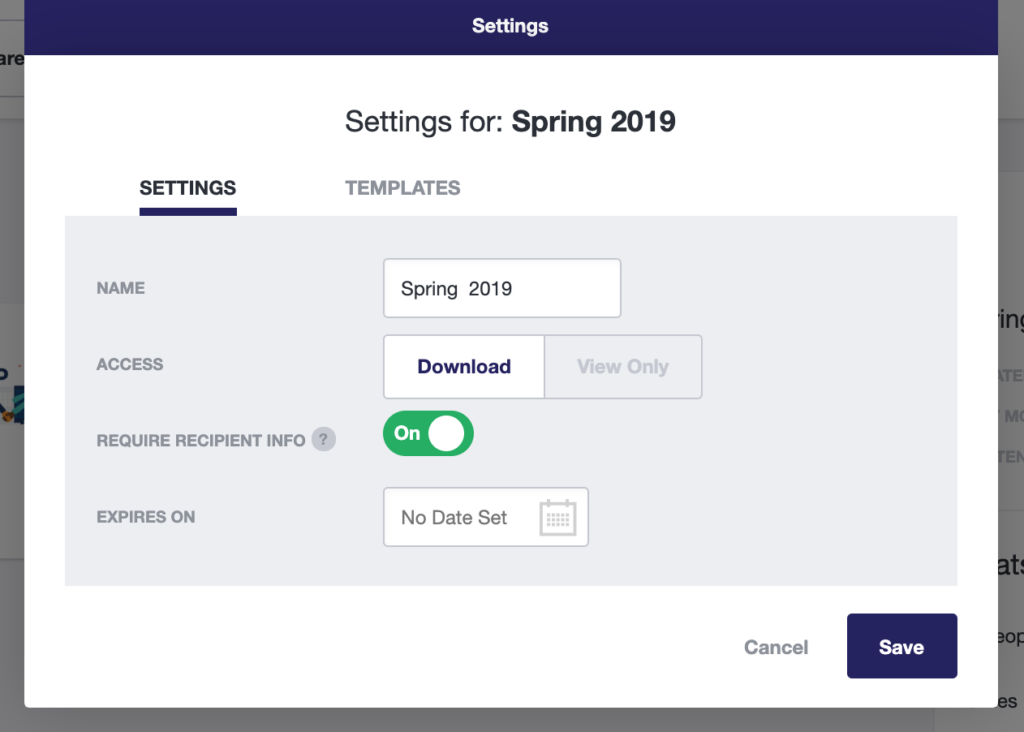
Image Relay offers many sharing and collaboration features that cater to a variety of needs within an organization.
Collections in Image Relay allow users to gather, organize, and share assets for specific projects or campaigns. Users can invite collaborators to these collections, making it easier to manage assets across teams and with external partners. Collections also support notifications, keeping all users updated on any changes or additions.
Moreover, Image Relay streamlines the review and approval process by centralizing feedback directly within the DAM system.
Digital Proofing allows team members to provide detailed, oriented feedback on assets, compare different versions, and view historical comments, which significantly reduces the risk of miscommunication and speeds up project completions.
Image Relay also provides various methods to share assets, including the ability to share single files, multiple files, entire collections, or embed links for integration on websites and other digital platforms.
This flexibility ensures that assets can be shared in the most appropriate format and through the most effective channels depending on the project requirements.
These features make Image Relay a powerful tool for organizations that need to manage their digital assets efficiently while collaborating extensively both internally and externally.
OpenAsset
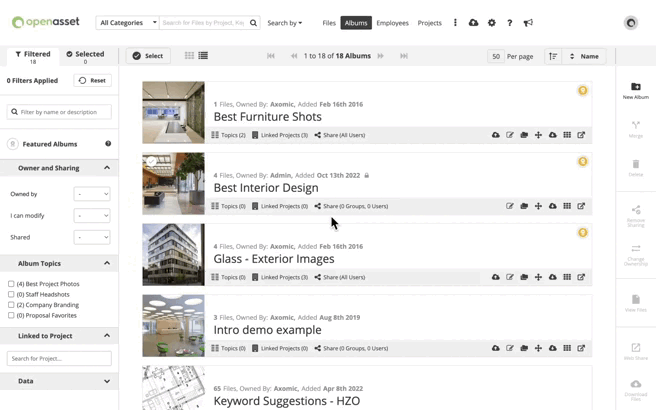
OpenAsset offers robust sharing and collaboration features tailored for the AEC industry.
For example, OpenAsset streamlines the process of securely sharing images and digital assets, ensuring that only intended recipients have access when needed. The platform provides extensive control over asset distribution with capabilities like download monitoring and external access restrictions.
This level of security provides organizations of any size with the assurance that their valuable assets are protected and only accessible to authorized personnel.
Additionally, OpenAsset allows users to share collections of assets with both internal and external partners. These collections can be distributed via links, which can be secured with passwords or set to expire for added security.
Furthermore, OpenAsset’s version control feature is invaluable for collaborative projects, which often involve multiple revisions of documents. This feature ensures that all team members are working with the most current versions of documents and visual assets, maintaining precision and accuracy essential in many professional fields.
Lastly, OpenAsset users can effortlessly create a Portal and provide access to colleagues, partners, and clients through a unique link. This link showcases a preview of images, accompanying contextual information, and, if desired, download links—eliminating the need for third-party file-sharing services like WeTransfer or Dropbox.
These features make OpenAsset a compelling choice for organizations in the AEC sectors that need to manage their digital assets efficiently while extensively collaborating both internally and externally.
Integrations
Integrations in a DAM tool allow the system to seamlessly connect with other software and platforms that businesses commonly use. This connectivity enhances productivity, streamlines workflows, and ensures that digital assets are accessible where and when they are needed, without the need to switch between different systems.
Integrations also help reduce unnecessary clicking, saving you valuable time, and keeping your brand consistent across various platforms.
The integrations that your company needs will largely depend on the specific needs of your industry. Here’s a comparison of the integrations offered by Image Relay and OpenAsset to illustrate how each caters to different professional needs:
Image Relay
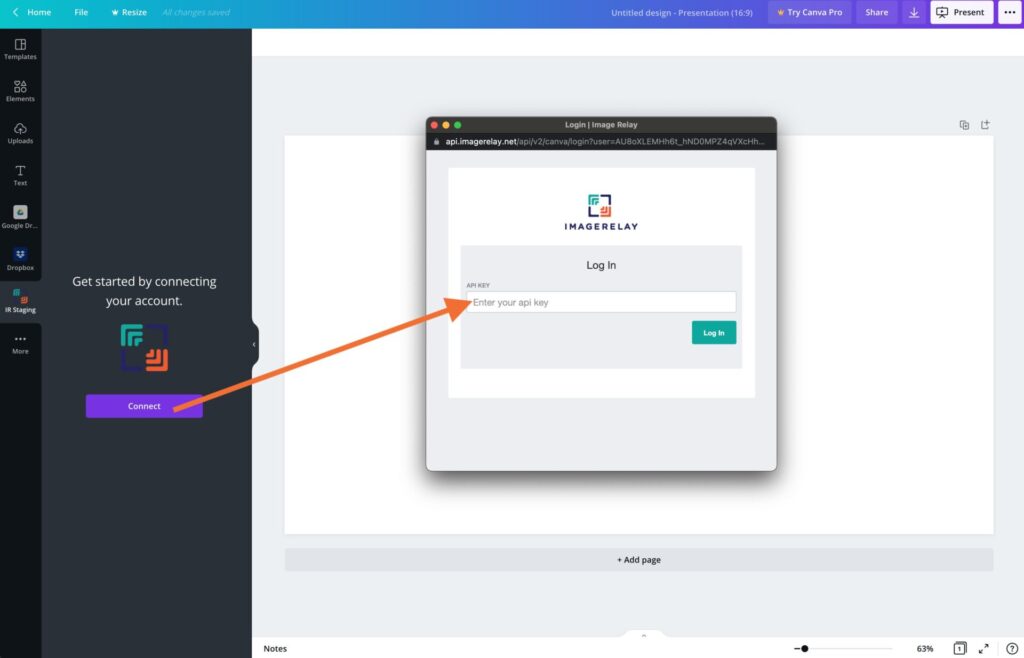
Image Relay offers a comprehensive suite of integrations that can benefit various industries by connecting their digital asset management processes with other business tools and platforms.
Some notable integrations offered by Image Relay include:
- Adobe Creative Cloud (Photoshop, Illustrator, InDesign)
- Canva
- WordPress
- Salesforce and HubSpot
- Google Drive, Dropbox, OneDrive
- Airtable
- Asana
- Marketo
- Shopify
- Social media platforms
- Wrike
These integrations are beneficial to marketing teams, creative professionals, social media managers, and sales teams, providing them with the tools to efficiently manage and utilize digital assets across various platforms and applications.
This interconnectedness not only saves time but also enhances consistency and accuracy across digital content.
Moreover, like with OpenAsset, through Zapier, Image Relay integrates with 1000+ applications, enabling automated workflows that can trigger actions in Image Relay or other apps based on predefined conditions.
OpenAsset

OpenAsset is specifically tailored for the AEC industry, integrating seamlessly with the tools and software commonly used within these fields, such as leading CRM and ERP systems, as well as Adobe products. These integrations enhance the workflow for digital asset management and project tasks, precisely addressing the distinct requirements of the AEC industry.
OpenAsset integrations include:
- Procore
- AEC 360
- Deltek Vision
- Deltek Vantagepoint
- Affinity
- Microsoft Word, PowerPoint, and Excel
- Okta
- Salesforce
- Unanet/ Cosential CRM
- Templafy
- InDesign
OpenAsset’s integration with document creation tools like InDesign enhances usability by allowing direct access to images from the asset library.
This integration supports a drag-and-drop feature that facilitates rapid uploading into InDesign and PowerPoint files. This method eliminates the need to separately search for and download assets, saving time and ensuring consistency across documents.
Not finding the integration you were hoping for? No problem! OpenAsset offers REST API access, providing the flexibility for organizations to create custom integrations with other critical tools they rely on for their operations.
Image Relay: Best DAM for General Features
Image Relay stands out as an excellent Digital Asset Management (DAM) solution for mid-market companies and a variety of industries that require a generalist yet robust set of features.
Unlike OpenAsset, which is highly specialized for the AEC sector, Image Relay offers a more versatile platform suitable for industries such as marketing, education, non-profits, healthcare, and retail.
This broad applicability comes from Image Relay’s intuitive user interface and a comprehensive suite of tools that support not just asset management but also Product Information Management (PIM).
Moreover, Image Relay’s Marketing Delivery platform, which offers a combination of DAM and PIM functionalities, makes it suitable for various industries that manage extensive product lines with numerous SKU codes.
Image Relay’s dual capability sets it apart, particularly for companies that require robust cataloging and distribution features. However, the additional costs for these advanced capabilities are not always transparent, and potential users should review their budget and the total investment required for implementation.
Additionally, its generalist approach provides valuable features such as secure file sharing, advanced metadata management, and versatile integration options, making it a reliable and scalable solution for managing diverse digital assets for companies in need of more basic DAM capabilities that aren’t tailored to any specific industry.
OpenAsset: Best DAM for AEC Firms
On the other hand, OpenAsset provides specific features that cater directly to the needs of the Architecture, Engineering, and Construction (AEC) sectors, which Image Relay does not offer.
Notably, OpenAsset’s Employee Module and its Artificial Intelligence (AI) capabilities are tailored to enhance project data and AEC proposals, making it particularly valuable for firms in these industries. These features are designed to streamline workflows and improve efficiency in managing project-specific digital assets and employee information.
Therefore, OpenAsset stands out for AEC firms due to its specialized features designed specifically for their needs, in contrast to broader platforms like Image Relay, which offer a more general feature set.
This focus on AEC-specific requirements makes OpenAsset especially suitable for firms in this industry, providing tools that enhance ease of use, project-based organization, and seamless integration with key AEC document creation software and partners, thereby optimizing workflow efficiency.
OpenAsset’s functionality is particularly advantageous for creating customized resumes for bid proposals, an essential task for AEC professionals.
Additionally, OpenAsset’s Portal feature is a game-changing innovation designed specifically for AEC firms looking to enhance their digital asset management and sharing processes. This new tool allows a highly customizable and centralized approach to sharing digital assets directly from the OpenAsset system.
OpenAsset’s ongoing commitment to enhancing its services for AEC marketing professionals underscores its dedication to the sector. This continual improvement and specialization make OpenAsset an unmatched DAM solution for the AEC industry, with numerous features specifically tailored to address the unique challenges faced by these firms.
| Hand-picked related content: Want to discover new ways you and your AEC form can use OpenAsset? Read our 5 Inspiring Ideas for Using OpenAsset Beyond Traditional Asset Management. |
Choosing the Right DAM: Image Relay vs. OpenAsset
When comparing Image Relay and OpenAsset, it’s crucial to align the DAM system with your organization’s specific needs, such as industry focus, team size, budget, and the particular functionalities required for your asset management.
Image Relay offers a broad feature set that appeals to a wide range of industries with its versatile and user-friendly platform. It is particularly suited for companies that need a DAM system to handle various types of digital content and integrate smoothly with other tools, enhancing overall marketing and sales efforts.
On the other hand, OpenAsset is specifically designed for the AEC industry, providing targeted functionalities that cater to the unique demands of project-based work. Its integration with AEC-specific tools and software makes it a superior choice for architecture, engineering, and construction firms that need a DAM system that can manage large volumes of project-specific digital assets effectively.
Both platforms offer significant benefits, but the best choice will depend on your specific industry requirements and how you plan to use the DAM system in your daily operations.
By understanding the strengths of each option—Image Relay’s versatility and OpenAsset’s industry specialization—you can make a more informed decision that aligns with your strategic goals and operational needs.
Understanding the unique capabilities and focus of each system will help you determine which DAM solution is the right fit for your organization, ensuring that you choose a tool that not only meets your current needs but also helps you win more business.
For a more comprehensive understanding, we provide in-depth comparisons of other platforms like Bynder, Brandfolder, Air, Adobe Bridge, and more, to help you evaluate all your options.
Ready to see OpenAsset in action?
The post Image Relay vs. OpenAsset appeared first on OpenAsset.